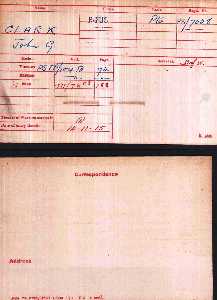Hornchurch Camp 1914/15
Interior of Hut at Hornchurch

Medal Card
John attended Westoe School.
He was married to Estella Clark, of Birtley, Co. Durham.
He enlisted and was trained at Hornchuch Camp.
John arrived in France on the 14th November 1915.
The following is an account of the 23rd Royal Fusiliers Battalion arrival in France and their first day of action:-
"The day of the move overseas arrived. This was on November 15, 1915, when the regimental transport entrained at Tidworth for Havre, followed one day later by the Battalion, which proceeded to Folkestone, Boulogne being reached on November 17, Ostrohove Rest Camp being the first objective. No time, however, was wasted there, for on November 18 the Battalion entrained at Pont-de-Briques, joining the transport which had come up from Havre.
It was at Steenbecque, reached a day later, and where billets were found in barns and farmhouses, that the sound of artillery in action was first heard by the Battalion. Four days were occupied here in sorting things out generally, the companies parading, route marching, and being inspected.
On November 23rd, a move was made to Busnes, the first part of the route being over badly cut up second-class roads, and the remainder on pavé. The men, the war diary tells us, marching in greatcoats, and carrying blankets, found the march very trying. Billets in the area La Miquellerie were reached at 3 p.m. Distance, 11˝ miles.
Then came a very important thing from a soldier's point of view. Pay was drawn from the Field Cashier, and distributed for the first time in France. Next came the notification that in conformation with the policy of re-forming the 33rd and the 2nd Divisions by forming brigades, each consisting of two new battalions and two regular battalions, the 99th Brigade was to lose the 17th and 24th Battalions Royal Fusiliers, receive the 1st Royal Berks and the 1st King's Royal Rifle Corps and join the 2nd Division.
On November 25 the Battalion paraded to march to their new billets at Bethune, being inspected en route by General Walker and the Staff of the 2nd Division. General Walker's opinion was that the 23rd Royal Fusiliers was one of the best battalions he had seen in Bethune.
Still moving, on November 26 the Battalion marched to Annequin, Fosse 9, and owing to the road being frequently shelled, orders were given that seventy-pace intervals should be kept between platoons east of Beuvry. To improve matters, it may be mentioned, there was a heavy fall of snow, and in the portion of the village south of La Basse the majority of the houses were in ruins, the result of frequent bombardments by the enemy.
Then began the first experience of the Battalion in warfare. Before being trusted to hold a line by itself it had to serve an apprenticeship. This was done by attaching, in the first place, platoons, then companies, and then the half-battalion to battalions in the line in order to learn the work and what was expected of them.
During this time much kindness was experienced from the regular battalions to which the attachments were made. The units of the Battalion not doing attachment duty were used for working parties in the trenches and suffered several casualties. No. 2 platoon, right flank company, specially suffered, being caught by shrapnel fire on the Bethune-La Basse road, ten N.C.O.'s and men being wounded".
He was captured by the Germans and died from wounds in a German POW Hospital on the 3rd May 1918.
He previously had been awarded the Military Medal on the 13th March 1918.
The War diary for this period is quite brief, but does indicate what may have happened to him to earn the MM.
"The afternoon of March 12 saw the Battalion back in the trenches again at Lincoln Reserve and Midland Reserve, "D" Company being in Snap Trench. There was a heavy gas-shell bombardment by the enemy on the nights of the 12th, 13th, and 14th, the Battalion suffering heavy casualties, also intermittent shelling during the day and night, while there was, as a welcome change, a raid on the enemy front line by the Battalion on the night of March 13-14. Then came the relief of the Battalion, which marched back to Equancourt, a rest for the Battalion being absolutely necessary owing to the fact that all the remaining members were suffering from gas poisoning."
[During the war Le Cateau had been a German railhead and the site of an important hospital centre. The military cemetery was laid out by the Germans in February 1916 with separate plots for the Commonwealth and German dead.]
He is remembered at Harton on H104.03, at South Shields on S86.039, S86.081 and S86.082
He is also remembered in the ROH War diary History of the 23rd Battalion Royal Fusiliers
South Shields Grammar School
The CWGC entry for Private Clark

